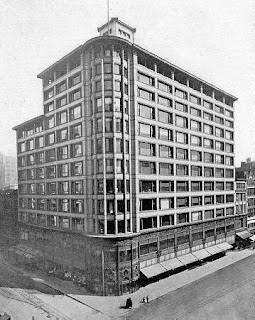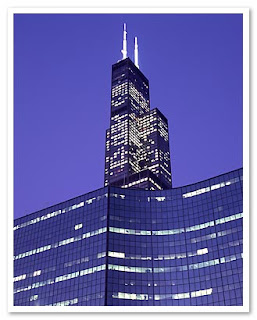 Carson, Pirie, Scott and Company building, Chicago. Louis Sullivan, 1903.
Carson, Pirie, Scott and Company building, Chicago. Louis Sullivan, 1903.The coolest building in the universe. Here's why: there's the ridiculously intricate wrought-iron work at street level, which always gets a lot of attention. There's also somewhat less intricate decoration around the upper windows. And those windows are placed in a regular grid on the façade. So if you stand right next to the building, as your gaze travels from the wrought-iron to the decoration on the first couple of rows of windows to the upper stories receding in perspective, the amount of decorative detail reaching your eye stays constant. Sullivan was building fractals before anyone knew what a fractal was. Breathtaking. (Really, any Sullivan building would merit this list.)
 Fairstead (Frederick Law Olmsted National Historic Site), Brookline, Mass. F.L. Olmsted (landscape), 1883-.
Fairstead (Frederick Law Olmsted National Historic Site), Brookline, Mass. F.L. Olmsted (landscape), 1883-.Again, any Olmsted project could have served (I don't care that they're not buildings, his work is better than 99% of the architecture out there, so keep your semantics to yourself), but I'll go with the grounds around the rambling old farmhouse that was his home and studio for the latter part of his life. In a lot of ways, it's the ultimate Olmsted project, because at first, it doesn't seem like he's really done much of anything, and then you remember that you're looking at a one-acre residential plot in a Bostonian suburb, and you realize that he's done everything, every tree, every shrub, every roll in the lawn, and it all flows together like a dream.
 Sears Tower, Chicago. Bruce Graham, Skidmore, Owings, & Merrill, 1973.
Sears Tower, Chicago. Bruce Graham, Skidmore, Owings, & Merrill, 1973.I didn't really appreciate the Sears Tower while I lived in Chicago. It was only after I moved away and started flying into Chicago that I finally got it. Seeing the thing from a plane window, surrounded by other buildings, the staggered square tubes seem to break through the cityscape like columns of granite. It's a great effect: a mountain peak rising out of a nominally flat landscape. Maybe the International style was less about not emulating biological organicism and more about giving geology a little respect. (Photo by our good friend Mark Meyer.)
 MIT Chapel, MIT, Cambridge, Mass. Eero Saarinen, 1955.
MIT Chapel, MIT, Cambridge, Mass. Eero Saarinen, 1955.Class of 1959 Chapel, Harvard Business School, Boston. Moshe Safdie, 1992.
So there's these two academic, non-denominational chapels, and they're both kinda small and intimate, and they're both circular, and they both have significant water elements (moat at MIT, interior koi pond at HBS), and they're both done in a modern style that nevertheless includes intriguing, idiosyncratic personal details. Lucky for Safdie he's so good, otherwise this would have plagiarism written all over it. Really, though, it's the differences that make each building: Safdie builds around a prismatic skylight that renders everything reflective and cool, Saarinen encases his geometric space in nubbly, irregular brickwork that's human and warm. News you can use: both spaces make terrific untraditional chamber music venues.
 Music Box Theater, Chicago. Louis A. Simon, 1929.
Music Box Theater, Chicago. Louis A. Simon, 1929.The plush velvet seating, the plaster faux-Venetian-palazzo details, the clouds painted on the vaulted ceiling, complete with electric blinking stars—you begin to know why movies were such a big deal back in the day. Think of it as a sublime pop version of the Isabella Stewart Gardner Museum, and you start to sense some of the magic. I remember seeing both Jacques Rivette's La Belle Noiseuse and Howard Hawks's Gentlemen Prefer Blondes here during my DePaul days, and it was the perfect venue for both. Neat trick.
 Honorable Mentions (any of which might have made the top five on a different day): Tribune Tower, Chicago (Howells & Hood, 1925; my wife's favorite building—detail at left); Isabella Stewart Gardner Museum, Boston (Willard T. Sears, 1923); Stata Center, MIT, Cambridge, Mass. (Frank Gehry, 2004); The Frick Collection, New York (Thomas Hastings, 1914); Mount Rushmore Visitors' Center, South Dakota (the old one, by Harold Spitznagel & Associates, 1957-63; demolished in 1994); Ozawa Hall, Tanglewood, Lenox, Mass. (William Rawn Associates, 1994); and probably more that I'm forgetting.
Honorable Mentions (any of which might have made the top five on a different day): Tribune Tower, Chicago (Howells & Hood, 1925; my wife's favorite building—detail at left); Isabella Stewart Gardner Museum, Boston (Willard T. Sears, 1923); Stata Center, MIT, Cambridge, Mass. (Frank Gehry, 2004); The Frick Collection, New York (Thomas Hastings, 1914); Mount Rushmore Visitors' Center, South Dakota (the old one, by Harold Spitznagel & Associates, 1957-63; demolished in 1994); Ozawa Hall, Tanglewood, Lenox, Mass. (William Rawn Associates, 1994); and probably more that I'm forgetting.

1 comment:
Aw man, The Music Box. Many a happy hour was spent there.
The Carson Pirie Scott building is a good if obvious Sullivan pick. I was always fond of the Krause Music Store around Lincoln Square .
Post a Comment